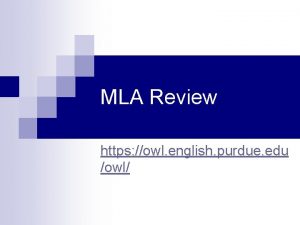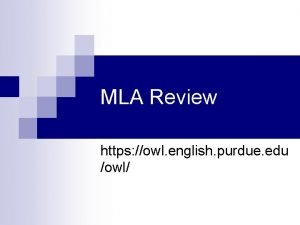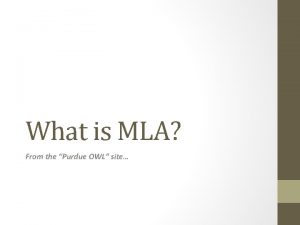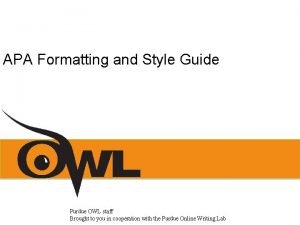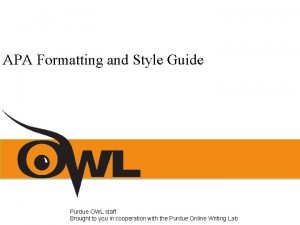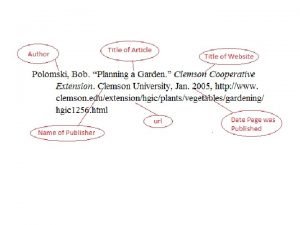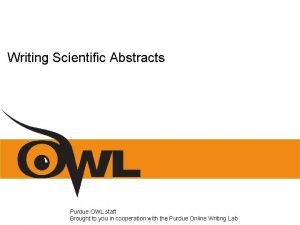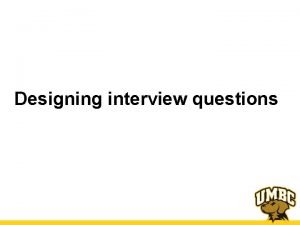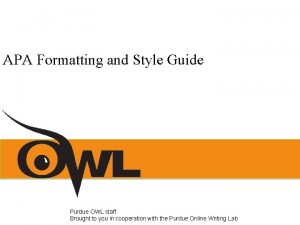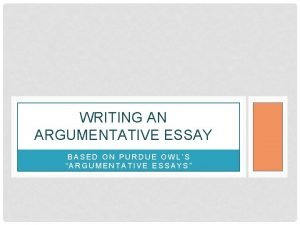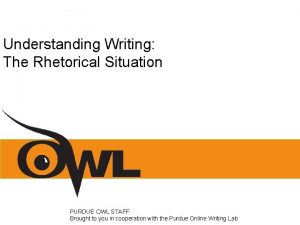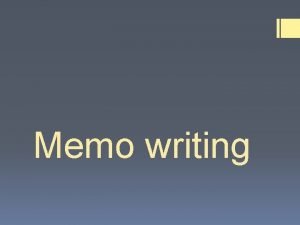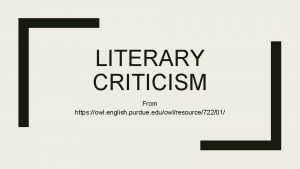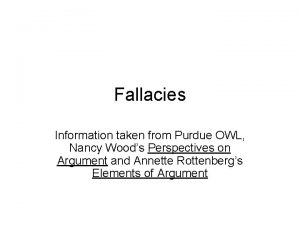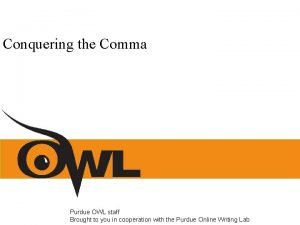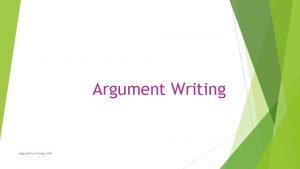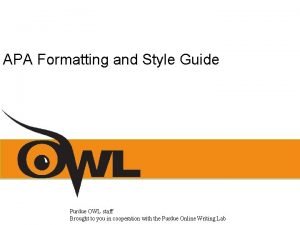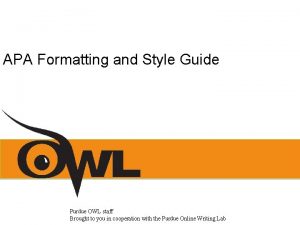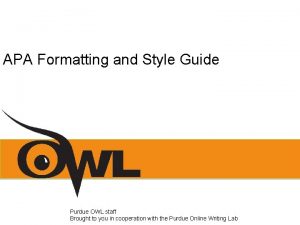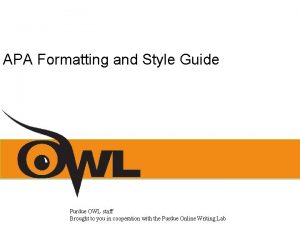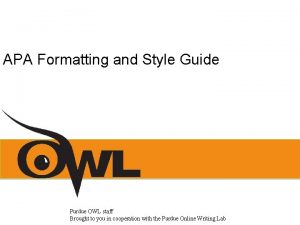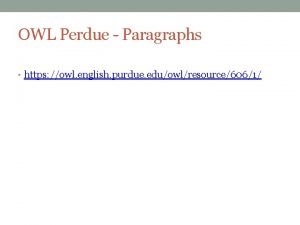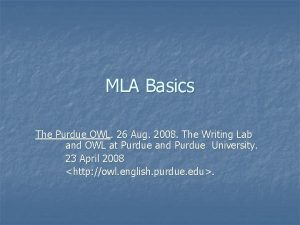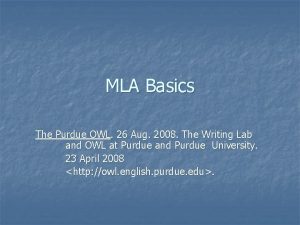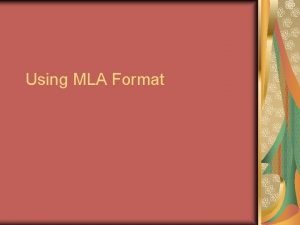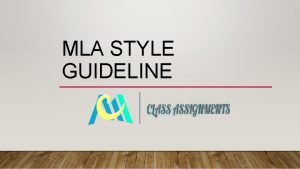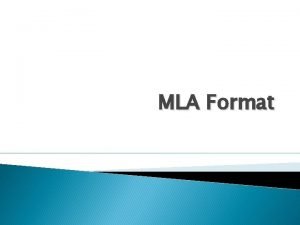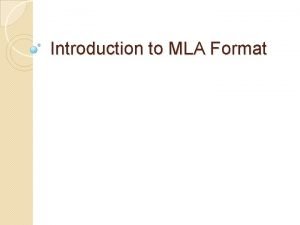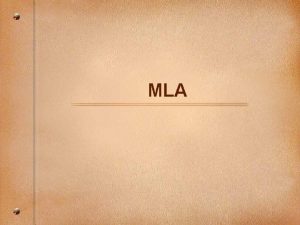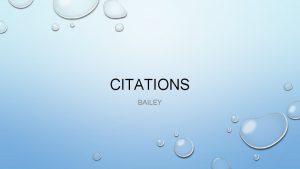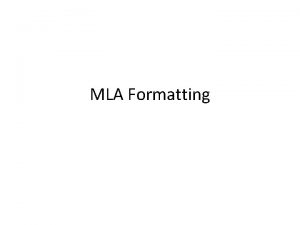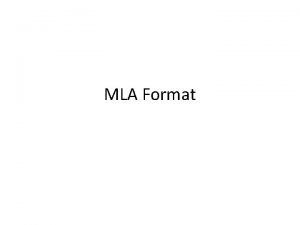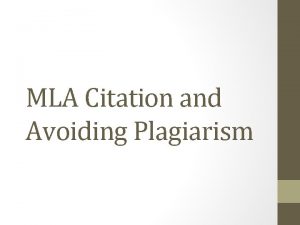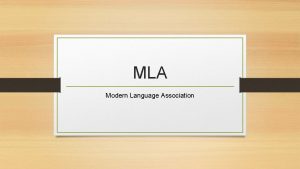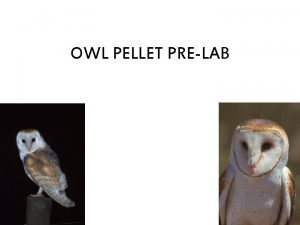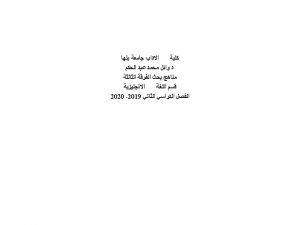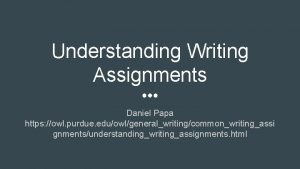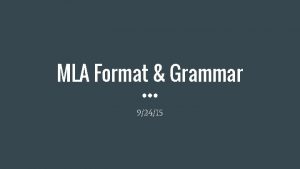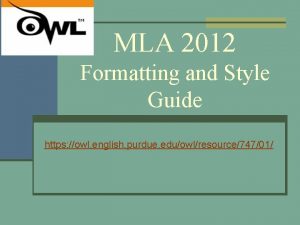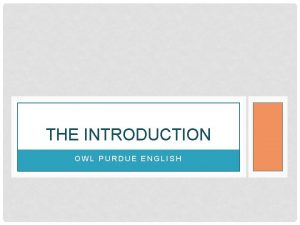MLA Review https owl english purdue edu owl

























- Slides: 25

MLA Review https: //owl. english. purdue. edu /owl/

MLA AT A GLANCE ■ MLA is a format, you may not deviate from the format or you risk plagiarism ■ Think of it as fill in the blank. ■ Capitalization, punctuation, spacing, and spelling are all important. Double, triple, quadruple check. ■ MLA has 3 main components: works cited, parenthetical citations, and page formatting.

Works Cited Start by consulting the list of core elements. These are the general pieces of information that MLA suggests including in each Works Cited entry. In your citation, the elements should be listed in the following order: 1. Author. 2. Title of source. 3. Title of container, 4. Other contributors, 5. Version, 6. Number, 7. Publisher, 8. Publication date, 9. Location. Each element should be followed by the punctuation mark shown here.

Author Begin the entry with the author’s last name, followed by a comma and the rest of the name, as presented in the work. End this element with a period. Ex: Said, Edward W. Culture and Imperialism. Knopf, 1994.

Title of source The title of the source should follow the author’s name. Depending upon the type of source, it should be listed in italics or quotation marks. A book should be in italics: Ex: Henley, Patricia. The Hummingbird House. Mac. Murray, 1999. A website should be in italics: Ex: Lundman, Susan. "How to Make Vegetarian Chili. " e. How, www. ehow. com/how_10727_make-vegetarian-chili. html. *

Title of source cont. . . A periodical (journal, magazine, newspaper) article should be in quotation marks: Ex: Bagchi, Alaknanda. "Conflicting Nationalisms: The Voice of the Subaltern in Mahasweta Devi's Bashai Tudu. " Tulsa Studies in Women's Literature, vol. 15, no. 1, 1996, pp. 41 -50. A song or piece of music on an album should be in quotation marks: Ex: Beyoncé. "Pray You Catch Me. " Lemonade, Parkwood Entertainment, 2016, www. beyonce. com/album/lemonade-visual-album/.

Title of container The eighth edition refers to containers, which are the larger wholes in which the source is located. For example, if you want to cite a poem that is listed in a collection of poems, the individual poem is the source, while the larger collection is the container. The title of the container is usually italicized and followed by a comma, since the information that follows next describes the container. Ex: Kincaid, Jamaica. "Girl. " The Vintage Book of Contemporary American Short Stories, edited by Tobias Wolff, Vintage, 1994, pp. 306 -07.

Title of container cont. . . The container may also be a website, which contains articles, postings, and other works. Ex: Zinkievich, Craig. Interview by Gareth Von Kallenbach. Skewed & Reviewed, 27 Apr. 2009, www. arcgames. com/en/games/star-trekonline/news/detail/1056940 -skewed-%2526 -reviewedinterviews-craig. Accessed 15 Mar. 2009.

Version If a source is listed as an edition or version of a work, include it in your citation. Ex: The Bible. Authorized King James Version, Oxford UP, 1998. Crowley, Sharon, and Debra Hawhee. Ancient Rhetorics for Contemporary Students. 3 rd ed. , Pearson, 2004.

Number If a source is part of a numbered sequence, such as a multi -volume book, or journal with both volume and issue numbers, those numbers must be listed in your citation. Ex: Dolby, Nadine. “Research in Youth Culture and Policy: Current Conditions and Future Directions. ” Social Work and Society: The International Online-Only Journal, vol. 6, no. 2, 2008, www. socwork. net/sws/article/view/60/362. Accessed 20 May 2009. Quintilian. Institutio Oratoria. Translated by H. E. Butler, vol. 2, Loeb-Harvard UP, 1980.

Publisher Note: the publisher’s name need not be included in the following sources: periodicals, works published by their author or editor, a website whose title is the same name as its publisher, a website that makes works available but does not actually publish them (such as You. Tube, Word. Press, or JSTOR). The publisher produces or distributes the source to the public. If there is more than one publisher, and they are all are relevant to your research, list them in your citation, separated by a forward slash (/). Ex: Klee, Paul. Twittering Machine. 1922. Museum of Modern Art, New York. The Artchive, www. artchive. com/artchive/K/klee/twittering_machine. jpg. html.

Publication date The same source may have been published on more than one date, such as an online version of an original source. When the source has more than one date, it is sufficient to use the date that is most relevant to your use of it. If you’re unsure about which date to use, go with the date of the source’s original publication. In the following example, Mutant Enemy is the primary production company, and “Hush” was released in 1999. This is the way to create a general citation for a television episode. Ex: “Hush. ” Buffy the Vampire Slayer, created by Joss Whedon, performance by Sarah Michelle Gellar, season 4, Mutant Enemy, 1999.

Publication date cont. . . However, if you are discussing, for example, the historical context in which the episode originally aired, you should cite the full date. Because you are specifying the date of airing, you would then use WB Television Network (rather than Mutant Enemy), because it was the network (rather than the production company) that aired the episode on the date you’re citing. Ex: “Hush. ” Buffy the Vampire Slayer, created by Joss Whedon, performance by Sarah Michelle Gellar, season 4, episode 10, WB Television Network, 14 Dec. 1999.

Location You should be as specific as possible in identifying a work’s location. An essay in a book, or an article in journal should include page numbers. Ex: Adiche, Chimamanda Ngozi. “On Monday of Last Week. ” The Thing around Your Neck, Alfred A. Knopf, 2009, pp. 74 -94. The location of an online work should include a URL. Ex: Wheelis, Mark. "Investigating Disease Outbreaks Under a Protocol to the Biological and Toxin Weapons Convention. " Emerging Infectious Diseases, vol. 6, no. 6, 2000, pp. 595600, wwwnc. cdc. gov/eid/article/6/6/00 -0607_article. Accessed 8 Feb. 2009.

Location cont A physical object that you experienced firsthand should identify the place of location. Ex: Matisse, Henri. The Swimming Pool. 1952, Museum of Modern Art, New York.

Works Cited ■ All sources used must be listed on the works cited page. ■ Follow the format exactly. ■ If the first required item (usually the author) is missing from your source, start with the next required item (usually the title). This happens a lot with websites. ■ If there are more than three authors or editors, list only the first one followed by et al. (meaning and others). ■ Sources are always cited alphabetically. ■ Use a hanging indent

Basic in-text citation rules In MLA style, referring to the works of others in your text is done by using what is known as parenthetical citation. This method involves placing relevant source information in parentheses after a quote or a paraphrase. General Guidelines ● The source information required in a parenthetical citation depends (1. ) upon the source medium (e. g. Print, Web, DVD) and (2. ) upon the source’s entry on the Works Cited (bibliography) page.

Basic in-text citation rules cont ● Any source information that you provide in-text must correspond to the source information on the Works Cited page. More specifically, whatever signal word or phrase you provide to your readers in the text, must be the first thing that appears on the left-hand margin of the corresponding entry in the Works Cited List.

Creating in-text citations The in-text citation is a brief reference within your text that indicates the source you consulted. It should properly attribute any ideas, paraphrases, or direct quotations to your source, and should direct readers to the entry in the list of works cited. For the most part, an in-text citation is the author’s name and page number (or just the page number, if the author is named in the sentence) in parentheses: Imperialism is “the practice, theory, and the attitudes of a dominating metropolitan center ruling a distant territory” (Said 9). or According to Edward W. Said, imperialism is defined by “the practice, theory, and the attitudes of a dominating metropolitan center ruling a distant territory” (9).

Long quotations For quotations that are more than four lines of prose or three lines of verse, place quotations in a free-standing block of text and omit quotation marks. Start the quotation on a new line, with the entire quote indented ½ inch from the left margin; maintain double-spacing. Your parenthetical citation should come after the closing punctuation mark.

Long quotations cont For example, when citing more than four lines of prose, use the following examples: Nelly Dean treats Heathcliff poorly and dehumanizes him throughout her narration: They entirely refused to have it in bed with them, or even in their room, and I had no more sense, so, I put it on the landing of the stairs, hoping it would be gone on the morrow. By chance, or else attracted by hearing his voice, it crept to Mr. Earnshaw's door, and there he found it on quitting his chamber. Inquiries were made as to how it got there; I was obliged to confess, and in recompense for my cowardice and inhumanity was sent out of the house. (Bronte 78)

Parenthetical Citations Tips ■ ■ ■ The parenthetical citation appears outside the quoted material. The period that ends the sentence comes after the close parenthesis. (This is different from long quotes) For long quotes place the parenthetical citation (the author’s name and the page number) after the period. Put brackets [ ] around any changes you make to a direct quote. There is no comma between the author’s name and the page number. If the quotation runs across more than one page: (Wordsworth-Fuller 20 -21) or (Wordsworth-Fuller 420 -21).

Paraphrasing and summarizing tips ■ Use paraphrasing and summarizing for variety, or to make a passing reference without taking up much space. ■ If you use an author’s idea, rephrased in your own words, you must still cite the idea.

■ ■ ■ MLA Formatting White paper, black ink. 1 -inch margins all around 2. 0 line height (double-spaced) no extra spacing after paragraphs 12 -point typeface (usually Times New Roman) Heading (upper left hard corner) (double spaced) � Your name � My name � Class and hour � Date Your last name and page number in upper right hand corner Title centered, no bold, no underline, no italics, same font and font size.

 Mla citation purdue
Mla citation purdue Purdue owl mla
Purdue owl mla Purdue owl mla poetry
Purdue owl mla poetry Purdue owl mla
Purdue owl mla Purdue owl apa in text citation
Purdue owl apa in text citation The purdue owl family of sites
The purdue owl family of sites How to quote dialogue
How to quote dialogue Purdue owl abstract
Purdue owl abstract Purdue owl mla interview
Purdue owl mla interview Apa referencing purdue
Apa referencing purdue Purdue owl argumentative essay
Purdue owl argumentative essay Rhetorical devices purdue owl
Rhetorical devices purdue owl There were fifteen candies in that bag
There were fifteen candies in that bag Purpose of the memo
Purpose of the memo Owl purdue critical race theory
Owl purdue critical race theory Owl purdue annotated bibliography
Owl purdue annotated bibliography Owl logical fallacies
Owl logical fallacies Apa format owl purdue example
Apa format owl purdue example Purdue owl comma
Purdue owl comma Purdue owl paragraph
Purdue owl paragraph Apa purdue owl
Apa purdue owl Apa style purdue
Apa style purdue Purdue owl apa paraphrase
Purdue owl apa paraphrase Purdue owl apa
Purdue owl apa Apa 7 purdue owl
Apa 7 purdue owl Purdue writing lab
Purdue writing lab
